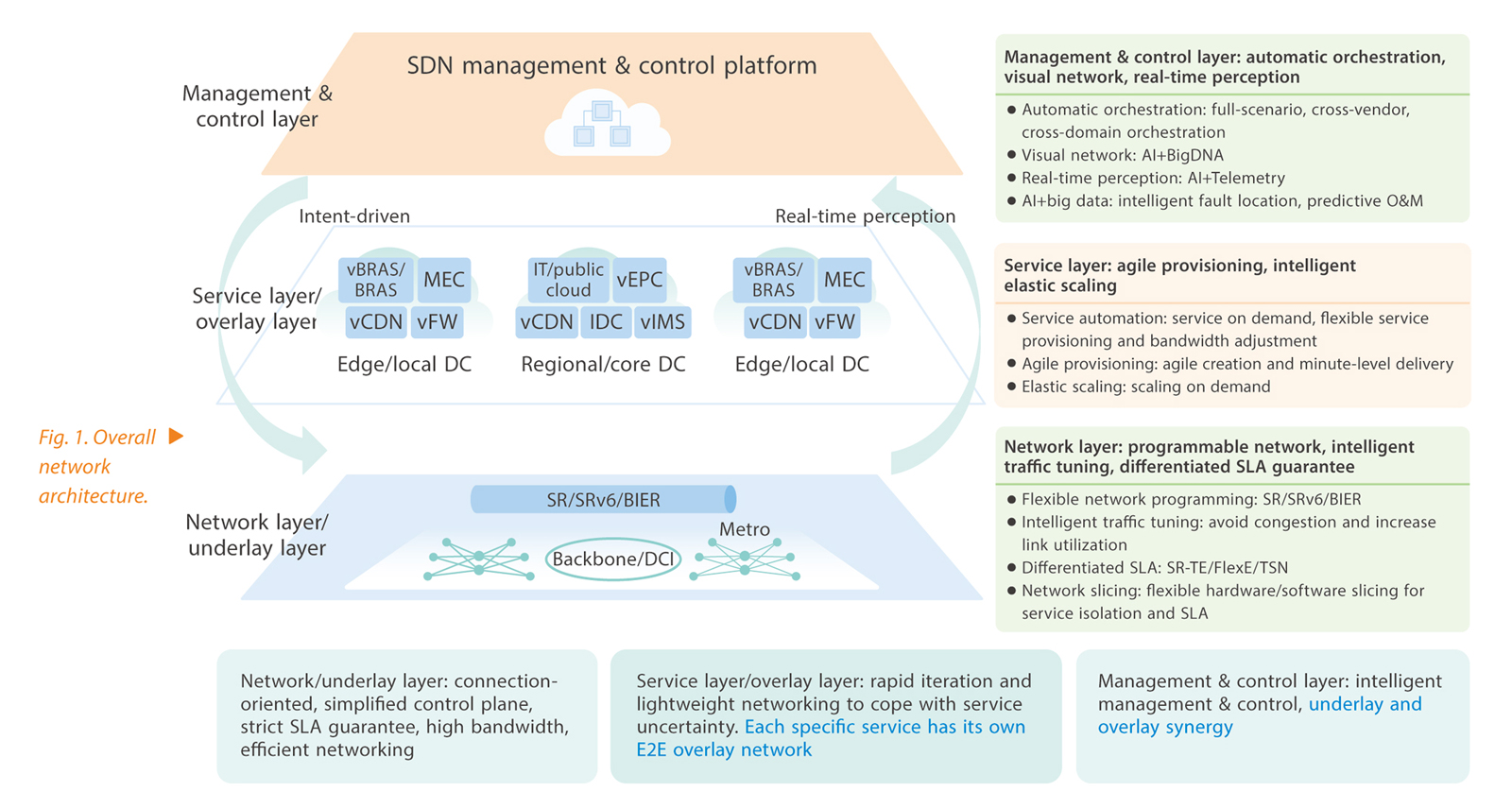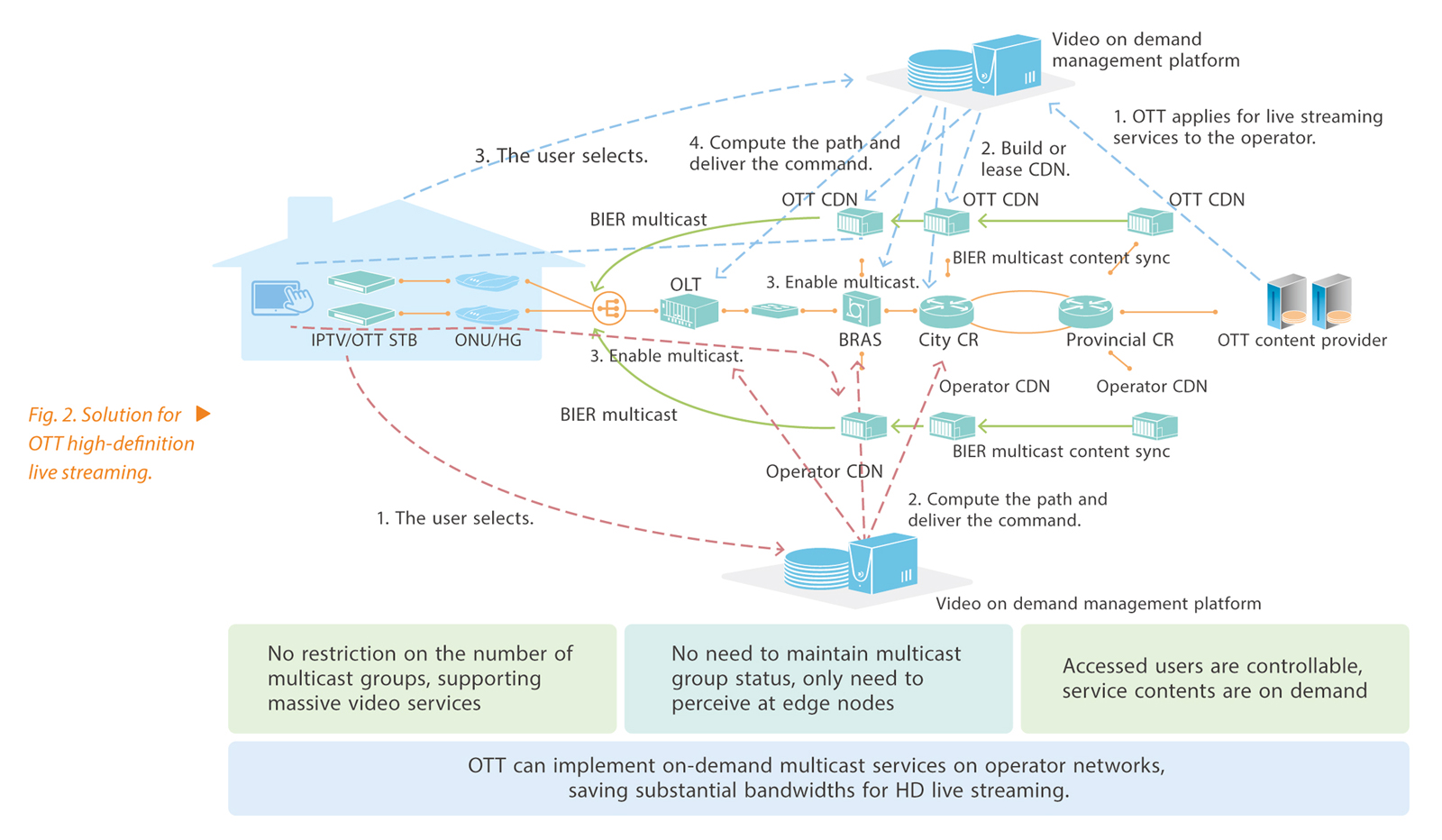With the advent of the 5G and cloud era, new services bring new opportunities for operators. VR/AR will become the next application with over 10 million users after IPTV, which brings ultimate experience to users while imposing high bandwidth requirements. It is expected that the network traffic will increase 10 fold over the next 10 years. With the application of 5G into various industries, the IP network will be expanded from the public network oriented to 2C services to the production network oriented to 2B vertical industries, bringing huge market opportunities. According to the forecast of MIIT and Gartner, by 2025 more than one million new enterprises will move onto the cloud, and 85% of enterprise applications will be based on cloud in China. To migrate massive enterprise applications to the cloud, the network should be able to support large bandwidth, fast provisioning, fast fault location and committed SLA for services.
How to meet the challenges imposed by new services on the network? ZTE believes that we need to adjust the network architecture first by designing an elastic, programmable, and intent-based network architecture based on AI and automation technology.
The IP network architecture oriented to the 5G and cloud era can be divided into three layers: network layer, service layer, and management & control layer (Fig. 1). The features of each layer are described below.

—
Network layer: It allows flexible network programming, intelligent traffic tuning and differentiated SLA guarantees. New networking technologies such as SR, SRv6 and BIER are used to make paths programmable and implement flexible service chain processing. Intelligent traffic tuning is used to avoid congestion of important services and improve link resource utilization rate. For differentiated SLA guarantees, SR-TE/FlexE/TSN technologies are used to allow the network layer to flexibly perform software and hardware slicing in accordance with service characteristics to guarantee service isolation and specific SLA attributes.
—
Service layer: It supports agile service provisioning and intelligent and elastic scaling. It can implement flexible on-demand service provisioning and dynamic bandwidth adjustment. The services can be created agilely, provisioned in minutes, and scaled on-demand.
—
Management & control layer: It supports automatic orchestration, network visibility and real-time perception. The automatic orchestration at the management & control layer is capable of full-scenario, cross-manufacturer and cross-domain orchestration. Big data collection and analysis is used to realize in-depth network visualization and real-time perception. AI is injected to implement intelligent fault location and predictive O&M.
Ultra-Broadband Network: High-Integration and Large-Capacity Core Chips Being the Cornerstone
The continuous increase in telecom network traffic increases operators' bandwidth costs and seriously affects operators' return on investment (ROI). Therefore, it is critical for operators to reduce transmission costs per bit while increasing the network capacity. In terms of the core engine of IP products—chips, ZTE has been committed to the development of in-house network processor (NP) and made technological innovations in the following aspects to improve the performance of NP.
—Parallel processing of multiple processors: Increasing the number of processors, enabling one processor to process multiple threads, and updating technology process to continuously improve the processing power of chips.
—Large-capacity internal storage: Internally integrating HBM and TCAM to break through the bandwidth bottleneck in processor table queries and packet processing cache access, ensuring sustainable improvement of NP performance.
—Ultra-high integration: Integrating 10 GE/40 GE/50 GE/100 GE/200 GE/400 GE MAC. ZTE's in-house NP is the first chip in the industry that is integrated with FlexE and supports time slot cross-connection at the PCS layer inside the chip. The delay of the chip can reach 1 us, providing strong hard slicing capability for 5G transport. Meanwhile, the chip compliant with 1588v2 can obtain ultra-high precision timestamps with their single-level precision reaching the industry-leading 1 ns, meeting the ultra-high-precision clock requirements of 5G transport. In addition, the chip is also integrated with large-queue TM to provide differentiated QoS guarantees.
ZTE's in-house high-performance NP can meet the urgent requirements of full-scenario services including 5G mobile, home broadband, private line and cloud for increasing network bandwidth, and help operators build ultra-broadband networks with ultimate experience.
In addition, the high density, high speed and high power consumption trends of IP equipment in the 5G and cloud era lead to rapid growth in power consumption and heat density. Dedicated to the R&D of innovative cooling technology, ZTE has proposed the dual-phase liquid cooling technology. The new liquid cooling technology has a heat dissipation capability of over 40 KW per integrated equipment. Based on the power consumption of existing chips, it can meet the heat dissipation requirements of super-large core routers with a capacity of 10T+ per slot. Compared with the traditional air cooling technology, it can reduce the noise by over 80% and the energy consumption by over 30%, showing obvious advantages in energy saving and consumption reduction.
Simplified Protocols: Simplifying Network Deployment and Opening the Network
ZTE has been cooperating with operators to actively explore new 5G business models and launch innovative network services to meet differentiated SLA requirements in 2C and 2B scenarios.
SR/SRv6 as the major transport protocol of the network eases the difficulty in cross-domain configuration due to various types of IP network protocols. The simplified protocol makes the automatic configuration more rapid and accurate. SRv6 intelligent routing is implemented, which allows the optimal path to be chosen based on the service delay requirement to guarantee the low latency requirement of key services.
ZTE is a leader in the development of the new multicast protocol BIER, contributing more than one third of BIER standards. The BIER multicast technology solves the innate defects of existing multicast protocols, such as the need to maintain a large amount of multicast state information at intermediate nodes and slow multicast route convergence. In combination with SDN, BIER enables on-demand multicast services (such as OTT video multicast service), saving a large amount of bandwidth (Fig. 2). OTT service providers can implement controllable multicast services on operator networks to provide HD video applications.

Deterministic Service Transport: Strict SLA Guarantee for 5G Applications in Various Industries In a traditional network, all services share and preempt bandwidth resources, so the bandwidths of key services cannot be guaranteed. Based on the hard isolation of FlexE network slices, ZTE implements zero bandwidth preemption among different services, and provides 100% bandwidth guarantee for key services of vertical industries. Based on the FlexE technology, ZTE proposes innovations to enhance TSN technology in several ways, such as TSN over deterministic fine-granularity channel of metro-transport network (MTN), to meet the deterministic requirements for delay, jitter and transmission of delay-sensitive applications in vertical industries (such as the differential protection service of smart grid and industrial control).
Intent-Based Network Based on AI and Automation Technology: Integrating Management, Control and Analysis
ZTE provides the industry's first network automation and intelligentization product that integrates management, control, analysis and AI functions to perform automatic and intelligent O&M during the full lifecycle of the network. Empowered by AI-based intelligent intent engine, the product can support rapid network planning, design and service deployment and accelerate new service provisioning.
Intelligent fault injection and analysis based on continuous learning allows faults to be rapidly perceived, accurately identified and located in minutes. At the same time, the health status of the physical network can be perceived in real time and the optimal network path can be selected based on service SLA to guarantee service experience and make service SLA visible, controllable, and committable. ZTE's intelligent management and control platform will be continuously improved to promote the evolution towards intent-based networks.
As the world's leading intelligent IP network provider, ZTE has been adhering to ultra-broadband, simplified and intelligent network ideology for the 5G and cloud era, and will use innovative technologies to help global operators build more intelligent IP networks.